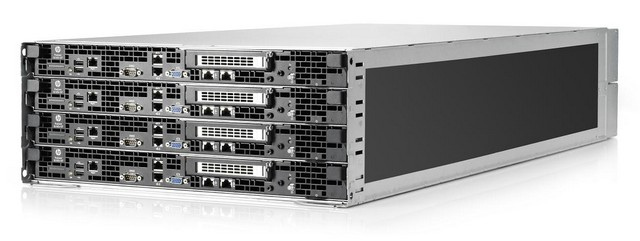New HP servers on AMD processors: SL165s G7 and SL335s G7

It is gratifying to see that such a large and reputable company like HP does not adhere to the same “party line” with regard to processors for its servers. The opportunity to face off to the advantage of the company itself and the users of its products is provided to both the largest vendors, Intel and AMD.
The alignment of forces is about the same as in the market as a whole, Intel processors prevail, but almost all popular lines sooner or later appear products on AMD processors. AMD Opteron performed particularly brightly last summer in the BL465c blade servers. Apparently, now the turn has come of servers of other form factors: HP has developed and has already presented to the public high density SL335s G7, 0.5U wide and more familiar outwardly SL165s G7, 1U wide.
Both models are installed in separate 4-unit chassis, rather than directly in a rack, and are designed for configurations that require easy and transparent scalability. They differ, by and large, the level of performance of a single server and the possibility of a more subtle step of increasing system power in the case of the SL335s G7, which can be installed up to eight pieces in the chassis, unlike the SL165s G7 - only four fit into the chassis. Both servers are installed in the SL6500 chassis.

As one of the uses for the SL165s G7, the deployment of serious web applications is mentioned. In the chassis of the SL6500 you can install four SL165s G7. Given that each server can have one or two twelve-core Opteron processors and 256 GB of memory, the overall chassis power can be absolutely transcendent, at the level of very decent blade baskets. But this is still a different segment, so for less money the user gets high performance, but narrower backup options. This is reflected in the number of power supplies, ventilation modules and expansion modules. They can be shared on several servers, which, on the one hand, allows for significant savings, but also somewhat reduces the overall reliability of the system in case of failures. But the chassis can work with an arbitrary number of servers of different configurations, which ultimately gives the user an unprecedented level of flexibility. The affordable minimum configuration allows you to lay the "cornerstone" of the chassis, then increasing the system, as at the level of each server, and the chassis as a whole.

The same applies to the older and “concentrated” SL335s G7. This HP server focuses on comparable tasks — high-performance computing, grinding powerful databases, and similar applications. Up to eight servers are installed in the chassis, with each of them carrying one or two six-core AMD Opteron and up to 128 GB of DDR3 memory.

Due to design constraints, disks in the hot-swap servers do not support, for all manipulations with them, you will have to shut down and remove the server. This is one of the tradeoffs associated with the high density of servers in the chassis and the overall concentration of elements.
Perhaps in the future, HP will also release disk modules for installation in the SL6500 chassis, which will further bring the system closer to blade solutions. But even if this does not happen, the SL165s G7 and SL335s G7 will remain a very attractive solution in situations where high power is needed, concentrated in a small volume and available at a relatively low price. And the issues of data storage can be solved with the help of inexpensive external shelves. Sharing power supplies and ventilation modules seriously reduces the cost of building a really powerful system worthy of a large company or service provider, which is worth a lot of money in our time.
')
Source: https://habr.com/ru/post/116053/
All Articles